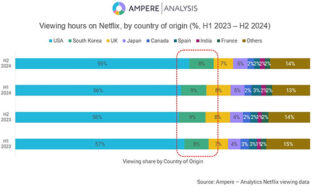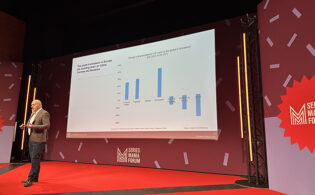Ampere Analysis has found that among 18- to 64-year-old internet users, smart TVs are now the predominant device for consuming content in the U.S.
Time spent watching content on smart TVs has increased by 27 percent since Q1 2021. This means almost one third (31 percent) of viewing time among internet users is via a smart TV, more than 1 hour and 30 minutes daily, higher than any other connected device.
Among this group, smart TV’s share of viewing overtook that of “regular” TV in Q3 2022 and has been growing since.
This has been driven by significant growth in ownership of smart TVs in the market, says Ampere. As of Q3 2024, ownership by U.S. internet users was 78 percent, versus just 59 percent in Q3 2016.
Samsung has retained its position as the top-owned brand in the market, but TCL is “growing rapidly.” The proportion of smart TV households that own a TCL device increased by nearly 50 percent between Q3 2019 and Q3 2024.
In Europe, 76 percent of internet users own a smart TV, up 25 percent over the past three years. The share of viewing time for smart TVs in Europe has increased at a similar rate, growing 25 percent between Q3 2021 and Q3 2024 in the region.
However, European internet users still spend proportionally more time with broadcast TV channels and a little less—just under an hour per day—with smart TV devices.
Annabel Yeomans, research manager at Ampere Analysis, said: “As engagement with streaming services continues to grow, so does the uptake of smart TVs, which provide easy access to a range of platforms. As one of the most advanced streaming markets globally, the U.S. has seen some of the strongest growth in uptake, and Ampere expects this to continue, particularly among older audiences who are watching more streaming services. In Europe, on the other hand, the strength of linear TV has meant a slower growth for smart TVs, but even here they are increasing share of viewing time.”






